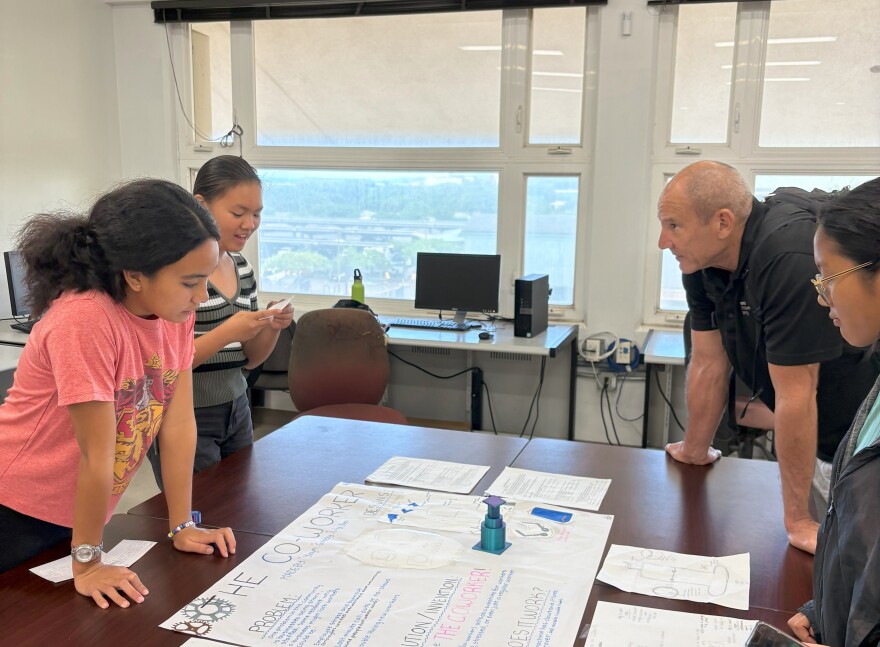A group of Maui middle school students has spent the summer 3D printing ʻohe kapala stamping sticks, creating scenes of the Hawaiian demigod Maui using virtual reality, and using drones in real-world applications.
It’s all part of a camp in partnership with the University of Hawaiʻi and a national Verizon program to foster technology education.
“The summer program is a three-week intensive program that takes the students through four technology tracks, artificial intelligence and robotics, 3D printing, coding, and augmented reality and virtual reality,” said Dirk Soma, a professor at UH Kauaʻi Community College and the Hawaiʻi director of the Verizon Innovative Learning STEM Achievers program.
He said students are applying their knowledge during various design challenges.
“They are also using the drone technologies and the Spheros, which are our rovers, to conduct soil samples, so they could use it in case of emergency preparedness in relation to what's happening in Lahaina with the Lahaina fires,” he explained.

The program first came to Hawaiʻi in 2021, and camps are now available to middle schoolers on Kauaʻi, Oʻahu, Hawaiʻi Island, and, as of last year, Maui.
Soma said statewide, there are about 300 participants — and half of those are on Maui. This year, the free program also opened up to West Maui students through transportation provided to the UH Maui College campus.
Shana Cao, an eighth grader from Lahaina, is using virtual reality to recreate the historic Baldwin Home for her final project.
“[It’s] one of the oldest standing houses in Lahaina, and it was damaged very severely in the 2023 wildfires,” she said. “So I just want to let other people see it and hopefully raise money to reach to reconstruct the actual Baldwin House at Front Street.”
Shana’s work allows viewers to walk back in time before the fire.
“We'll code the piano in the living room to show information. We can code the doors so that they can connect to other rooms,” she explained. “So the user can travel across around the house, to explore and see the different things of what the Baldwin missionary house used to be like.”

Soma said supporting the Maui community through the camp, particularly those in Lahaina, was important to organizers.
“Recovery doesn't happen overnight. So opportunities like this to get the students' mindset on positive things, and exposure and utilization of technology that might be able to create some great solutions going forward in their communities,” he said. “I think it also gives each family an opportunity to engage with their children and talk about not only the application of technology, but the responsible uses of technology.”
Along with exploring technology, the Hawaiʻi camps incorporate cultural themes.
Leimana Puʻu is a Hawaiian language immersion educator at Ke Kula ʻO Piʻilani in Wailuku, and an instructor at the Maui summer program.
She said that though technology and culture might seem unrelated, there’s a strong historical connection between them.
“Our ancestors were scientists,” she said. “They developed their own technology, and so to bring it back into curriculum, and even on a greater scale, with the type of resources that we have nowadays, it makes me confident to know that will where we're exposing our future leaders that will lift up our very own Maui community and our Hawaiʻi community in the near future.”
Puʻu taught the 3D printing class.
In the first two weeks of the program, they used 3D printers to explore a modern twist on a traditional art form.
“I was able to teach about traditional Hawaiian stamping and traditional Hawaiian clothing,” Puʻu explained. “It was normally made by carving out bamboo stamps that exhibited and expressed a reflection or a journey or a story. The hard part for the ʻohe kapala, or the bamboo carved stamps, is oftentimes we can't give our students knives and sharp tools to do these things."
"So through 3D printing, they were able to design, to reflect, to tell their story and their journey, create a symbolization of the things that they are experiencing as the youth in our community, and then be able to print those out and make their own type of kapala with the 3D printers.”
For their final project, Puʻu said one group tackled pollution by designing and creating handheld filters for microplastics found on the beach.
“They have big dreams, which is always good for our youth,” she said. “And so I'm hoping that from the three weeks that it only fed the dreams that they have already existing, and uplift them in the years to come.”
Hawaiʻi Public Radio exists to serve all of Hawai’i, and it’s the people of Hawai’i who keep us independent and strong. Help keep us strong to serve you in the future. Donate today.





